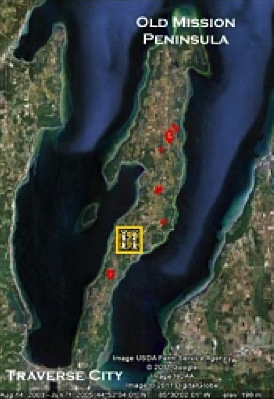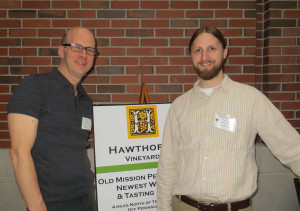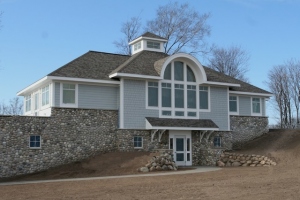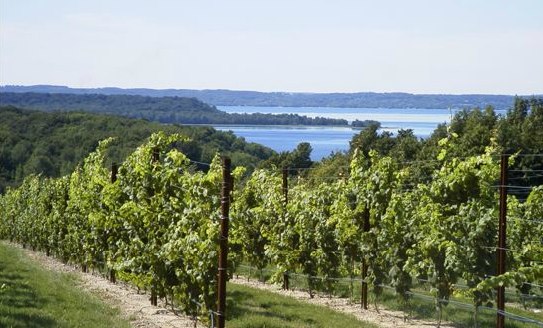Hawthorne Vineyards: A Welcome Addition To Old Mission Peninsula
 Old Mission Peninsula is only a stone’s throw from downtown Traverse City yet has a very different vibe than the city. While Traverse City is the largest metropolitan area in Northern Michigan, Old Mission Peninsula is serene, agricultural and laid back.
Old Mission Peninsula is only a stone’s throw from downtown Traverse City yet has a very different vibe than the city. While Traverse City is the largest metropolitan area in Northern Michigan, Old Mission Peninsula is serene, agricultural and laid back.
Hawthorne Vineyards is only the eighth winery on the beautiful peninsula. Opened in May of this year, the winery is the pride of owners Bruce and Cathleen Hawthorne. Cathleen, a master gardener, and Bruce, a corporate attorney, bought an 80-acre farm in 2005 to realize their dream of owning a vinifera-based winery. Cathleen’s family settled in Benzie County back in the 1800s, so they have deep roots here. With a total of 26 acres planted with a wide range of varietals, the operation strives to be ‘Pure Michigan”.
Brian Hosmer, of Chateau Chantal, another winery on Old Mission Peninsula, is the winemaker. Hosmer will split time between Chateau Chantal and Hawthorne. Paul Dalese manages the vineyards and is also from Chateau Chantal. While Hawthorne’s vineyards were previously managed by Chateau Chantal, the wineries are completely separate entities. Despite the joint venture, different owners and different perspectives are very evident. While Chateau Chantal produces approximately 20,000 cases of wine a year, Hawthorne is making about 2,500 cases annually. Vive la difference!
As with better wineries all over the globe, Brian Hosmer is focused on ‘letting the wines speak for themselves.” Expressing the terroir of the site is paramount for him. As seen in the map below, the vineyards are located in the southern, very narrow part of Old Mission Peninsula marked by the yellow “H.”
‘It’s considerably warmer here than on the rest of the Peninsula. We usually harvest one to two weeks before the other wineries. With the substantial layer of clay here, our wines have a luxurious texture and body to them,” explains Hosmer. He also believes the wine’s depth and layers of flavor are enhanced by the vineyard’s location.
A wide variety of wines are produced at the winery ranging from two of the ‘big six” varietals- Chardonnay and Riesling- to Pinot Blanc and a semi-dry Gewürztraminer. Reds range from Pinot Noir to a Bordeaux-style blend. Brian made a Rosé from the bountiful 2012 vintage ‘just for fun.” Crafted using the saignée method (the juice is ‘bled” off after very limited contact with the skins), it’s a blend of 91% Pinot Noir and 9% Gamay.
Wines from Lemberger, an Austrian varietal also known as Blaufränkisch, are quickly gaining favor in Northern Michigan. This varietal is becoming more popular in the Midwest. Hawthorne’s version has flavors of plum, cherry and dark fruits. While the 2010 Lemberger is sold out, Brian aged the 2013 in all French oak with a dark toast to accentuate the spicy, peppery aromas of the wine.
The Hawthorne’s plan is to add plantings ‘slow and steady.” We want to have sales be the driving force behind what additional varietals we grow,” Brian states. This practical and economically savvy approach is reflected throughout their operations.
Focusing on local materials and recycling as much as possible are guidelines adhered to by the Hawthorne team. Using municipal compost together with additional pomace from the cellar, the team has help from Joe Scrimger, a soil biologist. ‘We feed the microbes in the soil, helping their immune systems stay healthy. Different blends of compost are used for each vineyard block,” according to Hosmer. This holistic approach is prevalent throughout the entire operation.
See related story: Are Mycorrhizae Effective in Midwest Vineyards
Using what nature provided, architect Bradley Wheeler, AIA, LEED AP, of Traverse City designed the winery and tasting room to blend seamlessly into the secluded site. From the fieldstones gathered by Cathleen Hawthorne and used to build the winery, to the private drive leading to the facility, the operation is unique. The views of West Grand Traverse Bay are spectacular. The location is surrounded by woods preserved from development and from neighbors as well.
Visitors to the tasting room are greeted by Jan VanMaanen, Hawthorne’s tasting room manger. The public areas of the winery are intentionally modest in scale. A conscious decision was made to ‘let nature do the talking” Jan explains. She mentions ‘that what really surprises our guests is how close we are to the city, yet it feels like a million miles away.”
The team at Hawthorne is very focused on the ‘roots” of the place. They place a high priority on the uniqueness of their winery, from the vineyard sites to the tasting room on the bluff.
As Old Mission Peninsula is the little brother to the bigger Leelanau Peninsula just across Traverse Bay, Hawthorne currently is the “little guy” among the area’s bigger wineries. And that’s just the way Hawthorne likes it.
This article is sponsored by MI Wine Barrel, makers of durable and economic stainless steel wine barrels.





